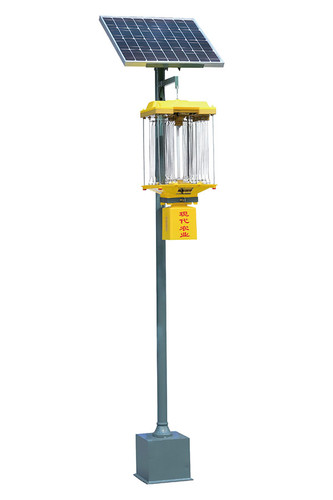Solar Panels: At the heart of a solar insect killing lamp is a solar panel. These panels are usually integrated into the top of the lamp, facing the sun during daylight hours. They capture sunlight and convert it into electricity through photovoltaic cells.
LED Lighting: Solar insect killing lamps use energy-efficient LED bulbs. These bulbs emit a warm and attractive light that simulates natural sunlight, luring insects toward the lamp.
Insect Attraction: Insects, naturally drawn to light sources, are attracted to the lamp. They perceive the light as a potential source of warmth and sustenance, leading them to fly closer to investigate.
Insect Capture and Control: Once the insects approach the lamp, they are directed into a capture mechanism. This mechanism can vary from one device to another and may include a fan that sucks insects into a collection chamber or a sticky surface that traps them upon contact.
Solar-Powered Operation: During the day, the solar panel charges the lamp's internal battery. This stored energy is then used to power the LED lights and the capture mechanism during the night, allowing the lamp to operate continuously without external power sources.
Benefits of Solar Insect Killing Lamps
Environmentally Friendly: Solar insect killing lamps rely entirely on solar energy, making them an eco-friendly solution that reduces energy consumption and carbon footprint.
Cost-Efficient: By utilizing solar power, these lamps significantly lower energy costs for homeowners while providing effective pest control.
Low Maintenance: Solar insect killing lamps are designed to be low maintenance. They often include self-cleaning mechanisms that clear away trapped insects, reducing the need for regular cleaning or maintenance.
Silent Operation: Unlike traditional bug zappers that emit loud and often irritating zapping sounds, solar insect killing lamps operate silently, making them suitable for peaceful outdoor settings.
Safe for Humans and Pets: These lamps do not use harmful chemicals or emit toxins, making them safe for humans and pets. They create a comfortable outdoor environment without the need for pesticides.
Versatile Use: Solar insect killing lamps can be placed in various outdoor locations, including gardens, patios, decks, and camping sites, effectively reducing the presence of annoying insects.
Considerations for Optimal Performance
Placement: Position the solar insect killing lamp in areas where insects are most active, such as near entrances, outdoor seating areas, or gathering spots.
Solar Exposure: Ensure that the solar panel receives sufficient sunlight during the day to charge the lamp's batteries adequately for nighttime operation.
Cleaning: While these lamps are designed to be low maintenance, occasional cleaning of the collection chamber or sticky surface is advisable to maintain their effectiveness.
Solar insect killing lamps are a testament to the potential of sustainable technology in solving everyday problems. By utilizing solar power and intelligent insect trapping mechanisms, they offer homeowners an eco-friendly and cost-effective way to enjoy bug-free outdoor spaces. These devices not only enhance the quality of outdoor living but also align with the growing trend toward environmentally conscious solutions. As more individuals and households embrace green living, solar insect killing lamps are set to become an essential tool in the fight against pesky insects, one ray of sunlight at a time.


 English
English 中文简体
中文简体











 ATTN: Crystal
ATTN: Crystal ATTN: Mila
ATTN: Mila

